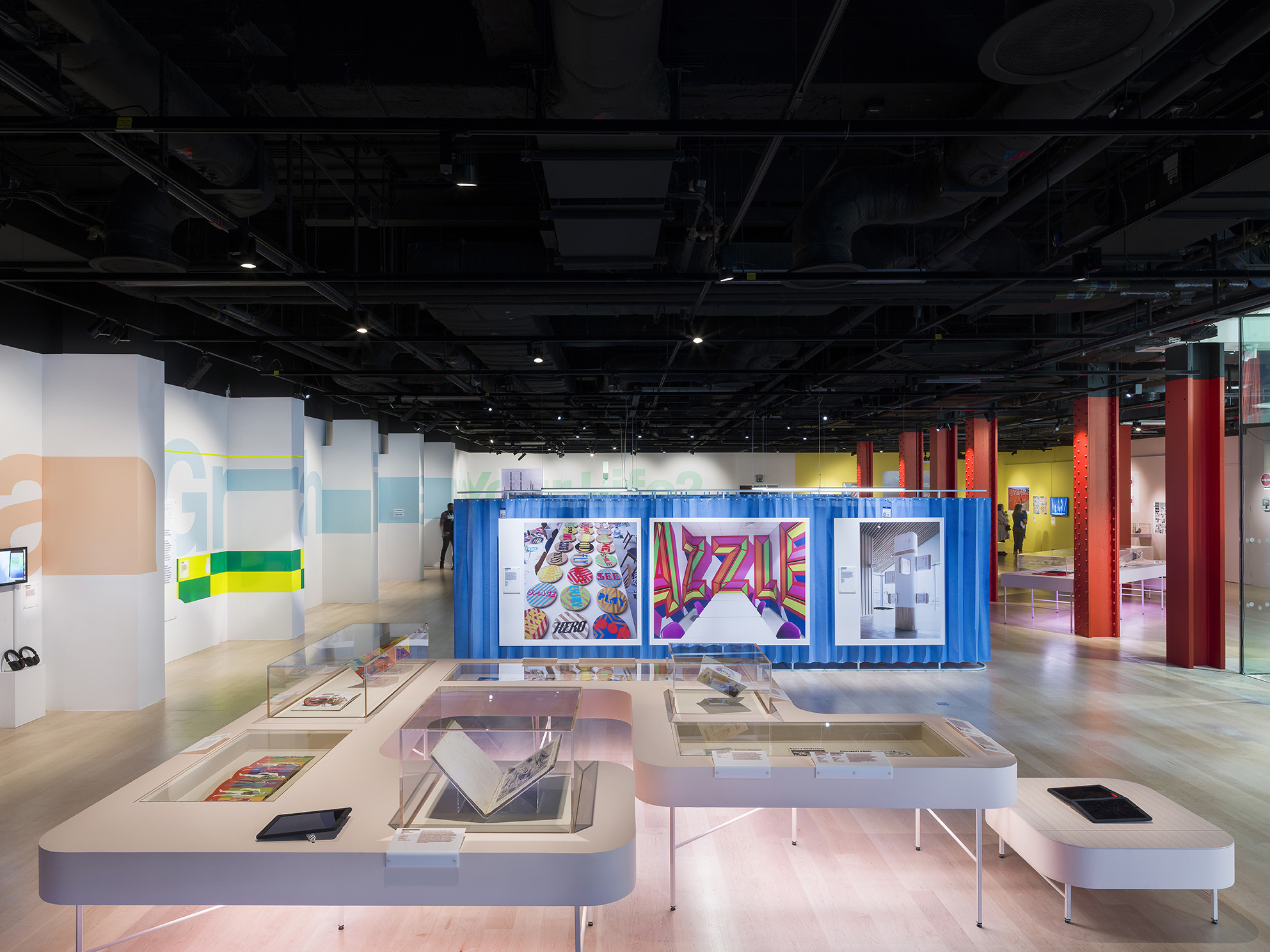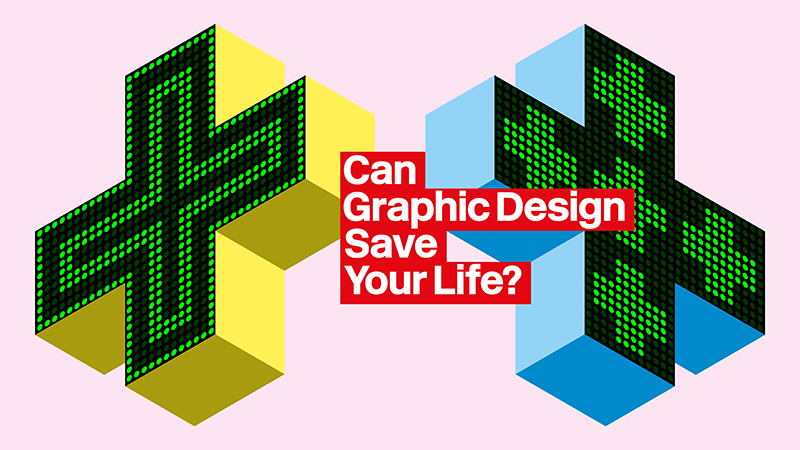Feburary 6, 2018
Can Graphic Design Save Your Life?- Exhibition Review
A healthy reminder: Can Graphic Design Save Your Life? It probably has
In wake of the recent Aussie flu epidemic sweeping across the UK many of us have been all too aware of the coughs and splutters on the tube. But are we as aware of the role that graphic design plays in the world of health and wellbeing?
The Wellcome Collection certainly seems to be. Throughout history symbols and signs have been used to communicate, and indeed they underpin much of the world around us – from street signs to magazines, we rely on this form of communication everyday.
At the beginning of the exhibition we are greeted by arguably two of the most iconic health signs – the green and red cross – which are signs for a pharmacy and a place of protection. This exhibitions gives a fresh perspective on graphic design and moves beyond the aesthetics towards questions of social responsibility.
The collaboration between graphic design and health is perhaps the most important crossover in society. Cultural barriers can be broken down by the use of graphic design to symbolise universal meanings which can persuade, inform and empower. ‘Can Graphic Design…’ explores 20th century design up to the present day and is sectioned into zones throughout one room. Themes of persuasion, education, hospitalisation, medication, contagion and provocation are explored through posters, videos and products alike.
This exhibition is playful in layout and in the use of colours such as yellow, bright blue, pale pink and green. Designed by Universal Design Studio, the exhibition itself attempts to replicate and redesign the atmosphere of the hospital environment making it a more child-friendly and engaging. Pairing pale blue curtains with powerful lighting and a complex floor-plan conjures up a familiar hospital feel. Displaying typography alongside product innovations and campaigns show just how wide reaching and dynamic graphic design is within the health sector.
In wake of the recent Aussie flu epidemic sweeping across the UK many of us have been all too aware of the coughs and splutters on the tube. But are we as aware of the role that graphic design plays in the world of health and wellbeing?
The Wellcome Collection certainly seems to be. Throughout history symbols and signs have been used to communicate, and indeed they underpin much of the world around us – from street signs to magazines, we rely on this form of communication everyday.
At the beginning of the exhibition we are greeted by arguably two of the most iconic health signs – the green and red cross – which are signs for a pharmacy and a place of protection. This exhibitions gives a fresh perspective on graphic design and moves beyond the aesthetics towards questions of social responsibility.
The collaboration between graphic design and health is perhaps the most important crossover in society. Cultural barriers can be broken down by the use of graphic design to symbolise universal meanings which can persuade, inform and empower. ‘Can Graphic Design…’ explores 20th century design up to the present day and is sectioned into zones throughout one room. Themes of persuasion, education, hospitalisation, medication, contagion and provocation are explored through posters, videos and products alike.
This exhibition is playful in layout and in the use of colours such as yellow, bright blue, pale pink and green. Designed by Universal Design Studio, the exhibition itself attempts to replicate and redesign the atmosphere of the hospital environment making it a more child-friendly and engaging. Pairing pale blue curtains with powerful lighting and a complex floor-plan conjures up a familiar hospital feel. Displaying typography alongside product innovations and campaigns show just how wide reaching and dynamic graphic design is within the health sector.




The investigation of trust in the ‘medication’ section was an interesting avenue of exploration and shows how branding can seep into many different industries. With challenges of communicating crucial information, it is no wonder the simple, abstract and strong colour layouts still dominate the pharmaceutical industry’s aesthetic.
It was insightful to learn about how graphic design is not only a method of communication but can also be a means of research. Within ‘contagion’, case studies such as Florence Nightingale’s findings on hospital environments, show how the visualisation of data can lead to reform. The role of non-static graphic design is an interesting element in the exhibition. Interactive forms of graphic design engage directly with the audience and even bring about change in their own right.
Some of the UK’s most iconic health campaigns are displayed, including the controversial AIDS advertisement which aimed to inform and shock the public. The role of using campaigns to shock continues to the presen day. Seen in the exploration of the ‘Kill Jill’ advertisement, the viewer is challenged to consider organ donation. After previous softer campaigns failed to be effective, this Scottish advertisement lead to an increase in donors by 300% (BBC News, 2008) despite the ad almost being banned. The ethical responsibilities of the graphic designer are subtly explored within these two campaign cases. These also follow on from the smoking advertisements in the ‘persuasion’ section, which explored how advertisements shifted from encouraging to discouraging smoking – certainly not the best way to develop trust in the audience.
In a society that is so used to extremes – from news stories to popular TV shows – it seems perfectly valid that the advertisement and campaigns of today keep in tune with the other forms of media we consume. Knowledge is definitely key when it comes to disease, prevention and wellbeing. The proposal that graphic design could make the world a better place is made visible throughout this exhibition in clear examples of how design has affected cultures around the world. Ultimately, collaborations of health authorities, activists and graphic designers are crucial in producing campaigns and other forms of communications that will affect mass sections of society. In the same way that a simple smile, coffee or hug can shape your day, graphic design has the simple power to affect your life (and you didn’t even know it).
References:
Can Graphic Design Save Your Life? explore ‘widespread and subliminal’ impact of design on health – Jenny Brewer, 5th September 2017 (itsnicethat.com)
Can Graphic Design Save Your Life? asks Welcome Collection’s new exhibition – Sarah Dawood, 31st August 2017 (design week.co.uk)
Can Graphic Design Save Your Life? (universaldesignstudio.com)
Ad prompts surge in organ donors – Branwen Jeffreys, 5th September 2008 (news.bbc.co.uk)
http://www.welcomecollection.org
http://www.graphicdesignand.com
All images belong to The Welcome Collection/Universal Design Studio
It was insightful to learn about how graphic design is not only a method of communication but can also be a means of research. Within ‘contagion’, case studies such as Florence Nightingale’s findings on hospital environments, show how the visualisation of data can lead to reform. The role of non-static graphic design is an interesting element in the exhibition. Interactive forms of graphic design engage directly with the audience and even bring about change in their own right.
Some of the UK’s most iconic health campaigns are displayed, including the controversial AIDS advertisement which aimed to inform and shock the public. The role of using campaigns to shock continues to the presen day. Seen in the exploration of the ‘Kill Jill’ advertisement, the viewer is challenged to consider organ donation. After previous softer campaigns failed to be effective, this Scottish advertisement lead to an increase in donors by 300% (BBC News, 2008) despite the ad almost being banned. The ethical responsibilities of the graphic designer are subtly explored within these two campaign cases. These also follow on from the smoking advertisements in the ‘persuasion’ section, which explored how advertisements shifted from encouraging to discouraging smoking – certainly not the best way to develop trust in the audience.
In a society that is so used to extremes – from news stories to popular TV shows – it seems perfectly valid that the advertisement and campaigns of today keep in tune with the other forms of media we consume. Knowledge is definitely key when it comes to disease, prevention and wellbeing. The proposal that graphic design could make the world a better place is made visible throughout this exhibition in clear examples of how design has affected cultures around the world. Ultimately, collaborations of health authorities, activists and graphic designers are crucial in producing campaigns and other forms of communications that will affect mass sections of society. In the same way that a simple smile, coffee or hug can shape your day, graphic design has the simple power to affect your life (and you didn’t even know it).
References:
Can Graphic Design Save Your Life? explore ‘widespread and subliminal’ impact of design on health – Jenny Brewer, 5th September 2017 (itsnicethat.com)
Can Graphic Design Save Your Life? asks Welcome Collection’s new exhibition – Sarah Dawood, 31st August 2017 (design week.co.uk)
Can Graphic Design Save Your Life? (universaldesignstudio.com)
Ad prompts surge in organ donors – Branwen Jeffreys, 5th September 2008 (news.bbc.co.uk)
http://www.welcomecollection.org
http://www.graphicdesignand.com
All images belong to The Welcome Collection/Universal Design Studio

